Artwork That Shows Race Ethnicity and Cultural Identity in Art
Equally The Office'due south Michael Scott (unintentionally) points out: in this solar day and historic period, nosotros and so fervently avert stereotypes, circumventing issues of race, gender, sexuality, etc. altogether, that we often finish up sounding more ridiculous and offensive. While it is certainly important and ideal to treat everyone as regardless of their racial identity, in reality this does not always pan out, namely inside the art world. How does the racial identity of an artist impact how they produce artwork, and how it is viewed by the masses? How does the historical presence of racial discrimination inside fine art affect contemporary multi-cultural artists and their work? Is talking about an artist's gender, racial or sexual identity in relation to their work celebratory or divisive?
Equally discussed in a previous post, Art History as a subject field faces an uphill battle when trying to highlight and define "good art" to the masses; without neglect, we end up neglecting plenty of good artists who, for ane reason or another, didn't make the "top 100" listing. As humans, we tend to have a demand to categorize in order to sympathise; Because of this, nosotros end up unintentionally marginalizing some groups and glorifying others, depending on the identity of the storyteller recounting history. Because mainstream history has been written past the elite and, at the very least, the literate, what happens to the marginalized cultures who rising upwards after being unable to present their side or the story for then long? When they finally gain the ability to speak for themselves, how practice they choose to do and then?
These questions unravel further questions when dealing with African-American artists, and in defining the ever-evolving identity of African-Americans within fine art: How exercise we define African-American identity in art? How do we reconcile African-American fine art inside the larger context of Art History? About importantly, are we paying attention to how each artist defines his or herself, equally opposed to how we ascertain them?
Creative person Kerry James Marshall discusses the desire amid black artists to be referred to simply as "artists," without the demand to insert a qualifying racial identifier in their title.
Cultural identity is defined just as much past its own members' search for and cosmos of definition every bit it is by the perceptions and propaganda of others and, more specifically, past those in power.
Both before and afterwards the Civil State of war, African-Americans were depicted by mainstream visual culture as caricatures, both every bit an try by the white mainstream to ascertain what it didn't understand, and to keep from elevating the status of African-American culture. This took an obvious form in the "mammy" archetype, as well as artwork relegating African-Americans to subservient roles, such as entertainer, cook, caretaker and retainer.
Images from the mid to late 19th century stereotyped and caricatured physical features of African-Americans, as well equally items that withal connected black culture to slavery (such equally watermelon, which was piece of cake and cheap to grow on plantations, and given to slaves to avoid aridity while working long hours in the fields).

Our Jolly Cook (from Campaign Sketches), Winslow Homer, 1863, Lithograph, Virginia Historical Gild, bequest of Paul Mellon
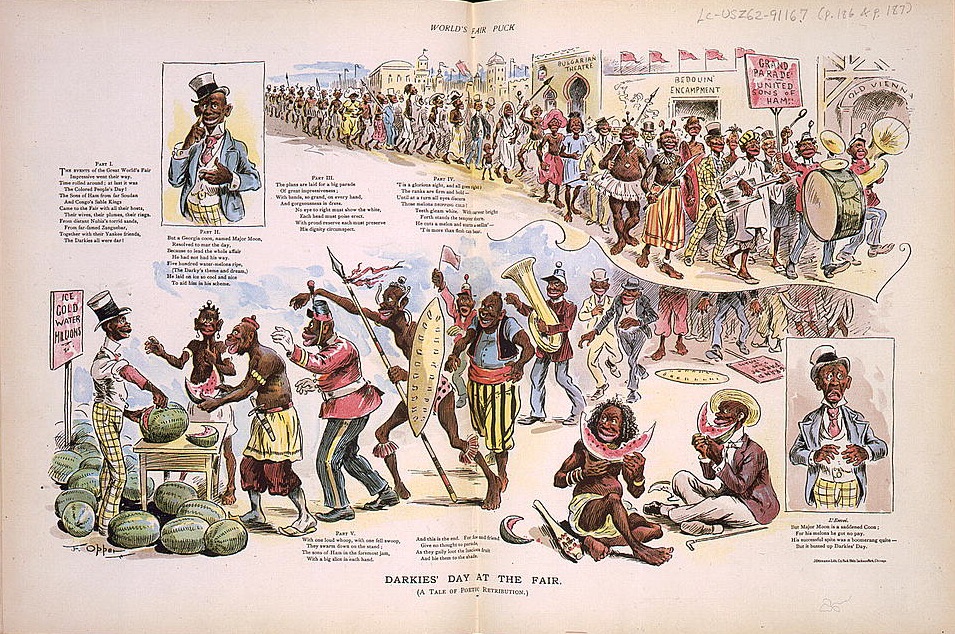
Darkies Day at the Globe Fair, Frederick Burr Opper, c. 1893, lithograph, colour. Composite of caricatures of black people, many of them in various costumes, at Chicago World's Fair.
" data-medium-file="https://maryckhayes.files.wordpress.com/2012/10/allcoonslookaliketome_hogan.jpeg?w=232" data-large-file="https://maryckhayes.files.wordpress.com/2012/10/allcoonslookaliketome_hogan.jpeg?w=463" class="size-full wp-image-410" title="All Coons Look Alike To Me, Ernest Hogan, 1896." alt="" src="https://maryckhayes.files.wordpress.com/2012/10/allcoonslookaliketome_hogan.jpeg?w=1180" srcset="https://maryckhayes.files.wordpress.com/2012/10/allcoonslookaliketome_hogan.jpeg 463w, https://maryckhayes.files.wordpress.com/2012/10/allcoonslookaliketome_hogan.jpeg?w=116 116w, https://maryckhayes.files.wordpress.com/2012/10/allcoonslookaliketome_hogan.jpeg?w=232 232w" sizes="(max-width: 463px) 100vw, 463px">
Sheet Music Illustration for Ernest Hogan's (in)famous song "All Coons Expect Alike to Me, 1896
The "mammy" archetype was characterized as a maternal, de-sexualized, non-threatening female person domestic function, often depicted as grossly overweight, hostile toward men, and usually a form of "sassy" comic relief.
This Mammy stereotype was perpetuated, and still is, through popular advert.
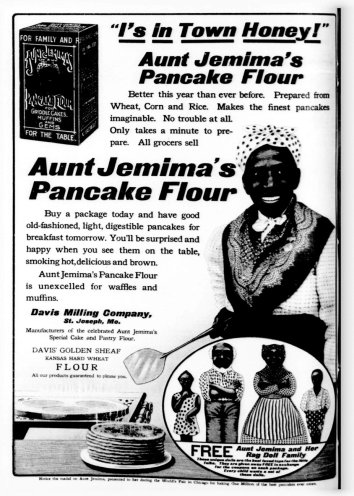
Aunt Jemima Advertisement, 1909

1989 Aunt Jemima Logo
So, if you lot are an African-American artist living amidst this caste of cultural stereotype, how do you lot reconcile this in your ain piece of work? Do yous acknowledge your heritage and racial identity in your art? Or do you lot cull not to highlight what makes you "different" in order to be recognized as a fellow member of the established mainstream? Is at that place a heart ground?
During the Harlem Renaissance, a cultural movement in the 1920s and 1930s characterized by an explosion in African-American literature, music and art, there existed a heavy focus on re-conceptualizing African-American identity. Writer and philosopher Alain Locke (1855-1954) encouraged artists of the early 20th century to gloat their race by representing African-American subjects, and looking to African traditions in order to illustrate a sense of cultural pride and interest.
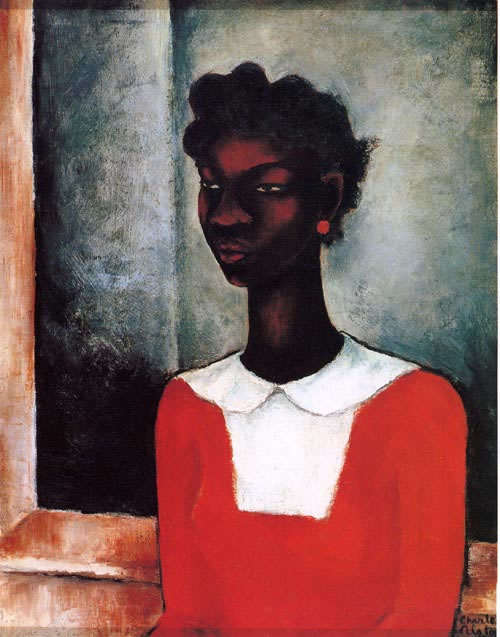
Girl in a Red Dress, Charles Alston, 1934, oil on canvas
Charles Alston's portrait Girl in a Crimson Clothes (1934) depicts an African-American woman without trace of caricature or stereotype; he represents her as a a portrait sitter in the European painting tradition, in modern, fashionable dress with a somber simply intent facial expression. The portrait contains a sense of psychological depth that yous do not run into in the cartoons or stereotyped images above; Alston shows her as beautiful and cultured, while nonetheless drawing on elements seen in traditional African art (ie: tribal masks) within her facial structure. Portraiture, a "safe" subject area matter for emerging artists in the late 19th century and early 20th century, involved patrons, and therefore was a stable style to make a decent living as an artist. Other scenes depicted by African-Americans involved dramatic renderings of the hardships of slavery, or turning to African art motifs equally an attempt to discover and institute African-American identity in the arts.
For example, Aaron Douglas chose to brand more straight references to African history in his work, as seen in his Building More Stately Mansions (1944). Douglas uses a restricted palette, geometric designs and silhouetted figures to requite his limerick a sense of Primitivism and reference creative styles seen in Egyptian art. In his painting, he reclaims Egypt as a slice of African past, and uses information technology to symbolize nobility and progress of his people.
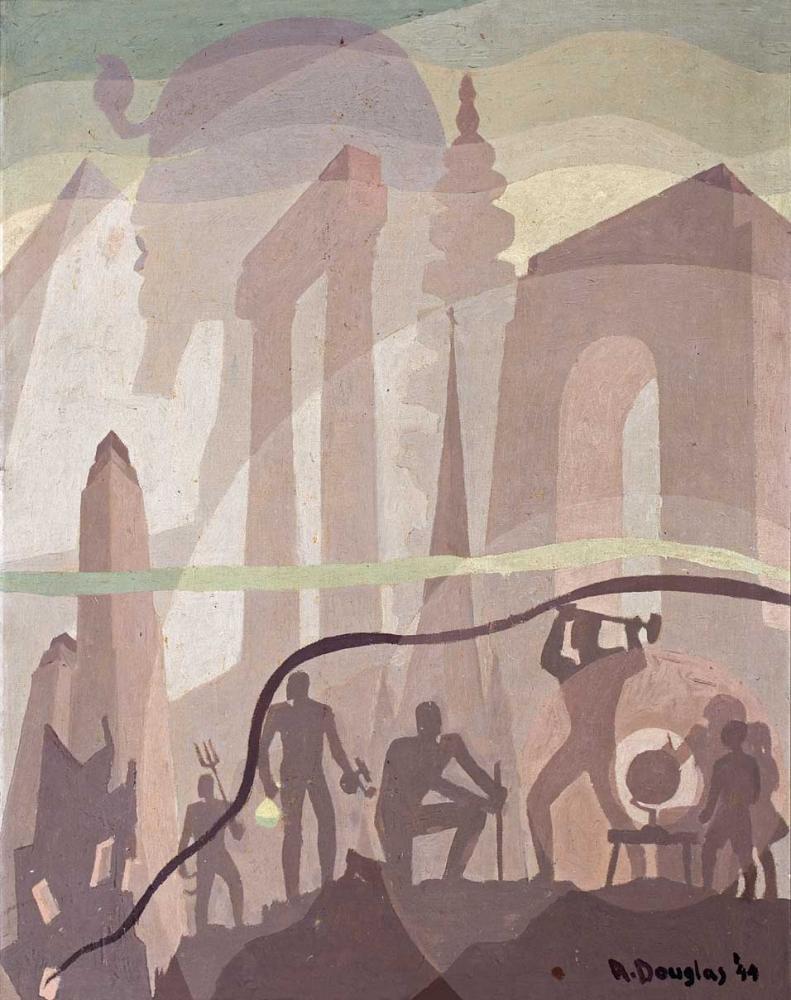
Edifice More than Stately Mansions, Aaron Douglas, 1944
Archibald J. Motley, Jr., was a Chicago creative person and graduate of the Schoolhouse of the Fine art Institute of Chicago (where many of his paintings now hang). Motley'south wanted to honestly stand for African-American civilisation beyond adhering to any racial restrictions or stereotypes. He painted black urban life as he saw and experienced information technology, illustrating genre scenes (events from daily life), in an attempt to bridge the race gap. In Motley's own words: "I've always wanted to pigment my people just the way they were."
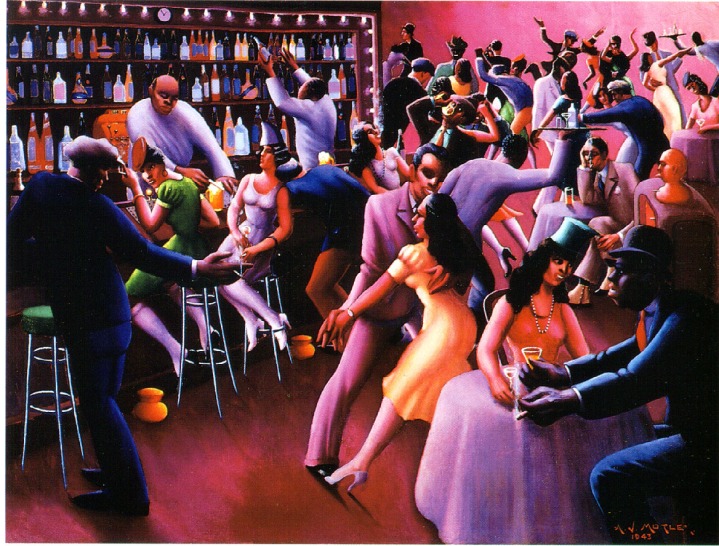
Nightlife, Archibald J. Motley, Jr. 1943, oil on canvas
For added outcome while you look at Nightlife, mind to Charlie Parker & Airheaded Gillespie recording beneath.
Like art and literature during the Harlem Renaissance, music was flourishing, particularly in African-American communities nearly big cities. The jazz movement, namely Bebop jazz, particularly reflects Motley'southward fashion (fast-paced and lively tempo, disorganized and improv-esque use of instruments). Imagine happening upon Motley'southward scene in a smoky, dimly lit room at 1:00am with bottles clanking, people laughing and fifty-fifty a few drunks falling asleep at their tables with lit cigarettes hanging from their mouths. As you look at this piece, your eyes literally move around Motley's composition to a beat, tracing the diagonals of the arms and legs from the bottom of the painting, through the oversupply and to the top. The lines inside the painting create rhythm, while the overall red tone sets the mood. Many of the chraracter's facial features reference traditional African art while still giving each person an private personality and role within the composition. Motley does not directly talk over stereotypes, nor historical events; he but aims to testify a grouping of young urbanites in their regular, nightly surround.
This racial and cultural dialogue has not concluded. Contemporary artists even so discuss and confront issues of race and art. Kerry James Marshall, who was seen in the video toward the beginning of this mail service, confronts marginalized black history past re-appropriating historical African images to become more heroic within in his own piece of work, and by emphasizing peel colour.
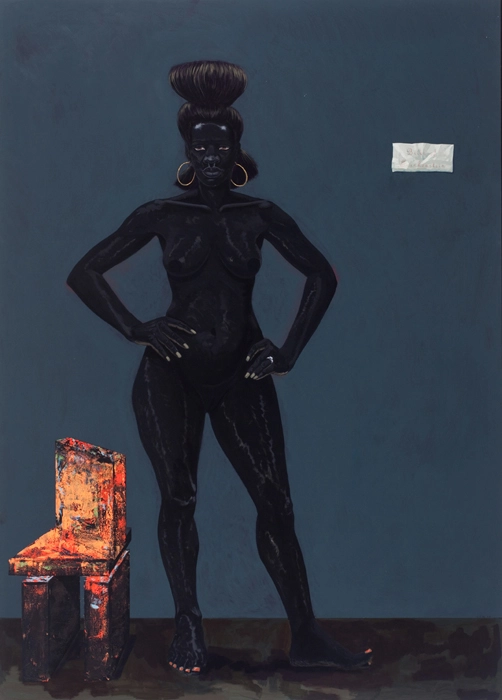

Untitled by Kerry James Marshall, 2009 acrylic on pvc 61 1/8 x 72 seven/8 x 3 7/viii inches
Some other contemporary artist, Kara Walker, mainly utilizes figural and narrative silhouette newspaper cut outs to annotate on race relations in by and present America. All of her figural cut outs, regardless of race, are rendered only in blackness paper, therefore not assuasive the viewer to differentiate between ethnicity based on skin tone. Instead, these racial variations tin just exist identified through stereotypical facial features that Walker emphasizes on purpose (ie: obscenely large lips on African-American figures). This is meant to make you uncomfortable and question your own stereotypical notions about different races. Her silhouettes are detailed further in a previous postal service.

Particular of Gone, An Historical Romance of a Civil War as It Occurred Between the Dusky Thighs of One Young Negress and Her Eye, 1994
Westward.East.B. Dubois, an author, historian and co-founder of the NAACP, describes a notion of double-consciousness in the lives and minds of African-Americans–an identity separate into factions, both insider and outsider–and having to reconcile 1'due south identity as seen within one'southward own civilisation, with how i is seen and critiqued by the mainstream civilisation:
It is a peculiar awareness, this double-consciousness, this sense of ever looking at one's cocky through the optics of others, of measuring ane'due south soul by the tape of a globe that looks on in amused contempt and compassion. One e'er feels his ii-ness,—an American, a Negro; two souls, ii thoughts, 2 unreconciled strivings; two warring ideals in one dark body, whose dogged strength alone keeps it from being torn asunder.
Some artists choose to face up race equally directly equally possible in their piece of work, even making the audition question their own identities. Adrian Piper'southward famous 1988 video installation slice entitled Cornered shows Piper, a lite-skinned African-American, speaking to her audience directly about her blackness, and how her acknowledgment of her race may brand the audience feel. Not only that, but she discusses the notion that a bulk of white people statistically accept black ancestry, and how beingness presented with that information makes the audition feel. She implicates everyone, black and white, as office of the problem and role of the solution.
I'm black. Now, let's deal with this social fact and the fact of my stating it together. Mayhap you lot don't see why we have to deal with information technology together. Maybe you think this is only my problem, and that I should deal with it by myself. Just it'southward not but my trouble, information technology'due south our problem….Y'all see, I take no choice. I'm cornered. If I tell you lot who I am, you become nervous and uncomfortable or antagonized. But if I don't tell you who I am, so I take to pass for white. And why should I have to do that? …..Y'all may be reacting to what I'm maxim as only an empty academic practice that has zip to do with yous. Just let's at least be clear about one thing: this is not an empty academic practice. This is real. And it has everything to do with you lot. It is a genetic and social fact that according to the entrenched conventions of racial classification in this country, you are probably black. So if I choose to place myself as black whereas yous practice not, that is non but a special personal fact about me. It's a fact about usa. It'southward our problem to solve, so how do y'all propose we solve information technology? What are you going to practice?
While this mail service is meant to give an overview of ideas related to racial identity within art, plainly these ideas merely represent a select few points of view inside a wide and beautiful artistic culture. As much as I'd similar to, I cannot mayhap comprehend everything inside the history of African-American Art (ie: I would love to write some other postal service solely dedicated to African-American art of the 1960s and 1970s, and another to discussing Jean-Michel Basquiat's life and work). Every artist mentioned here, and so many more, deserve their own museum catalog, let alone blog post.
Sources: **Note: A large portion of the references and ideas presented in this postal service came from a course chosen "The Black Aesthetic," created and taught past Professor Jordana Moore Saggese at Santa Clara Academy in the Winter of 2008. Saggese currently teaches at California College of the Arts in San Francisco.
Locke, Alain. "The Legacy of the Bequeathed Arts," from The New Negro (1925). Published in Hills, Patricia, editor Modern Art in the U.s.a.A.. New Bailiwick of jersey: Prentice Hall, 2001, 73-76.
Amy K. Mooney, "Representing Race: Disjunctures in the Work of Archibald J. Motley, Jr." Art Institute of Chicago Museum Studies, Vol. 24, No. ii, African Americans in Art: Selections from the Art Found of Chicago (1999), p. 162-179, 262-265.
Powell, Richard J. "Re/Birth of a Nation" in Rhapsodies in Black: Art of the Harlem Renaissance. Exhibition Catalogue. London: Hayward Gallery, the Institute of International Visual Arts, 1997.
Source: https://maryckhayes.wordpress.com/2012/10/12/racial-identity-in-art-the-black-aesthetic/
0 Response to "Artwork That Shows Race Ethnicity and Cultural Identity in Art"
Post a Comment